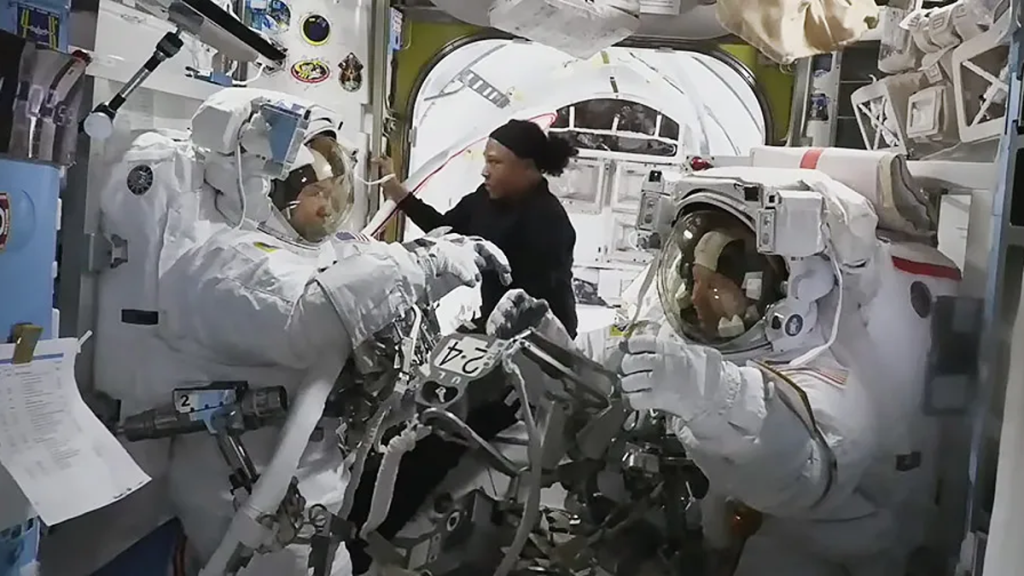
Two NASA astronauts were preparing to exit the International Space Station (ISS) for a second attempt at a spacewalk, but it was once again called off due to a concerning malfunction with the spacesuit.
NASA was forced to cancel a spacewalk on Monday due to a water leak in the service and cooling umbilical unit on astronaut Tracy Dyson’s spacesuit. “There’s water everywhere,” Dyson could be heard saying during the live feed from the ISS, pointing to an alarming malfunction with the space station’s aging suits that put other astronauts at risk in the past. NASA is in desperate need of new spacesuits for its astronauts, but in a troubling development, the company contracted to design the suits has just pulled out of the agreement.
The two astronauts, Dyson and Mike Barratt, hadn’t yet left the airlock when the issue arose. However, the airlock had to be re-pressurized as the pair were on their way out to the vacuum of space. Thankfully, the astronauts were safe.
This was the second spacewalk postponement within a week due to an issue with the spacesuit; on June 13, another spacewalk was called off due to “spacesuit discomfort issues,” according to NASA.
The astronauts on board the ISS are running procedure reviews of the spacesuit’s malfunction, troubleshooting it and inspecting the suit’s components. An upcoming spacewalk has been scheduled for July 2, pending the ongoing investigation.
It’s clear that NASA astronauts are in need of some new suits; the spacesuits currently being used are more than 40 years old and overdue for a major upgrade. The space agency also seems to be running out of fully functional space suits on board the ISS, with only 18 usable units currently available for use by astronauts on the space station, according to a 2017 report.
NASA is working with its commercial partners to develop new spacesuits for its astronauts on the ISS, but it’s taking longer than anticipated. In June 2022, the space agency awarded contracts to Axiom Space and Collins Aerospace to build spacesuits worth a potential combined value of $3.5 billion. The suits were meant to debut in 2025, but Collins Aerospace is looking to drop out of the contract, SpaceNews reported on Wednesday.
“After a thorough evaluation, Collins Aerospace and NASA mutually agreed to descope Exploration Extravehicular Activity Services (xEVAS) task orders,” the company wrote in a statement to SpaceNews. It’s not clear how NASA will proceed from here.
In May 2022, NASA suspended spacewalks outside the ISS following a series of potentially life-threatening incidents of water leaking into astronauts’ helmets during their spacewalks. NASA astronaut Raja Chari and European Space Agency astronaut Matthias Maurer were installing hoses on a radiator beam valve module outside the space station on March 23, 2022 when Maurer—who was venturing out on his first spacewalk—noticed some water and dampness inside his visor towards the end of the seven-hour spacewalk.
“NASA is thinking through the risk posture for these suits, which are aging, the [spacesuit] is currently no-go for planned EVAs pending an investigation into what they discover,” Susan Helms, a former NASA astronaut who serves on NASA’s Aerospace Safety Advisory Panel, said at the time. The space agency resumed ISS spacewalks shortly afterwards following an investigation into the leaks.
This wasn’t the first incident involving excess water. Back in 2013, ESA astronaut Luca Parmitano noticed a water leak inside his helmet that forced an early wrap-up to the spacewalk. Parmitano was able to re-enter the ISS airlock but was having difficulty breathing as 1.5 liters of water had formed inside his helmet. “I feel it covering the sponge on my earphones and I wonder whether I’ll lose audio contact. The water has also almost completely covered the front of my visor, sticking to it and obscuring my vision,” Parmitano recounted in a chilling blog post later.
The same suit worn by Parmitano nearly drowned another astronaut two years later. NASA astronaut Terry Virts, donning spacesuit #3005, noticed free-floating droplets of water and a damp absorption pad in his helmet at the conclusion of his spacewalk.
In a report released in January 2019, NASA’s Aerospace Safety Advisory Panel reviewed the increasing challenges of the spacesuits. “It is an undeniable fact that the 40-year-old EMUs used in ISS operations are reaching the end of their useful life,” the report read. “NASA cannot maintain the necessary, ongoing low-Earth orbit operations without fully functional EVA suits.”
For more spaceflight in your life, follow us on X and bookmark Gizmodo’s dedicated Spaceflight page.

